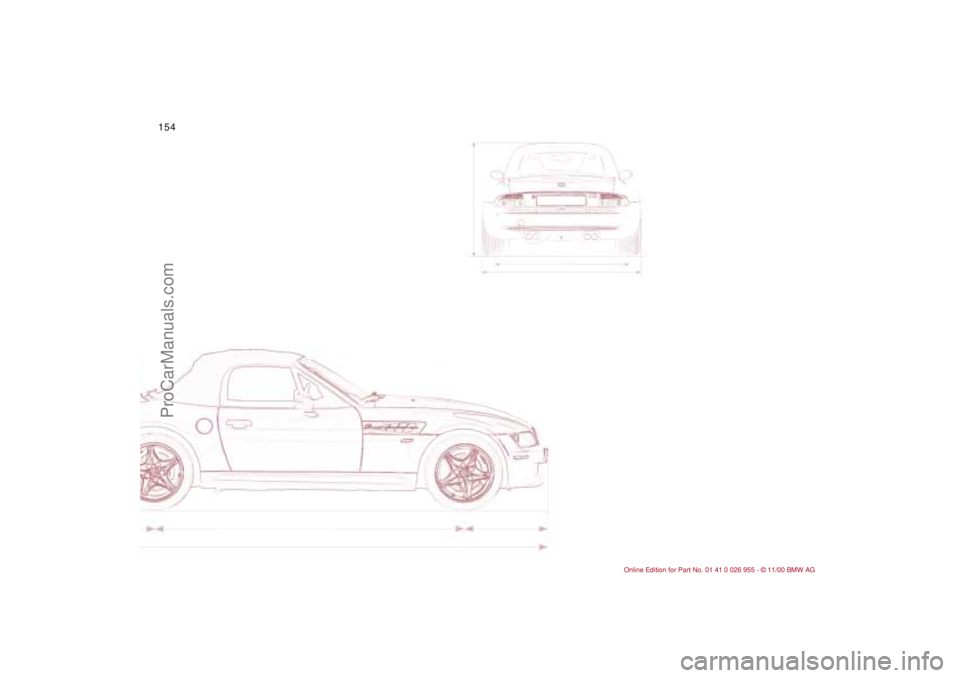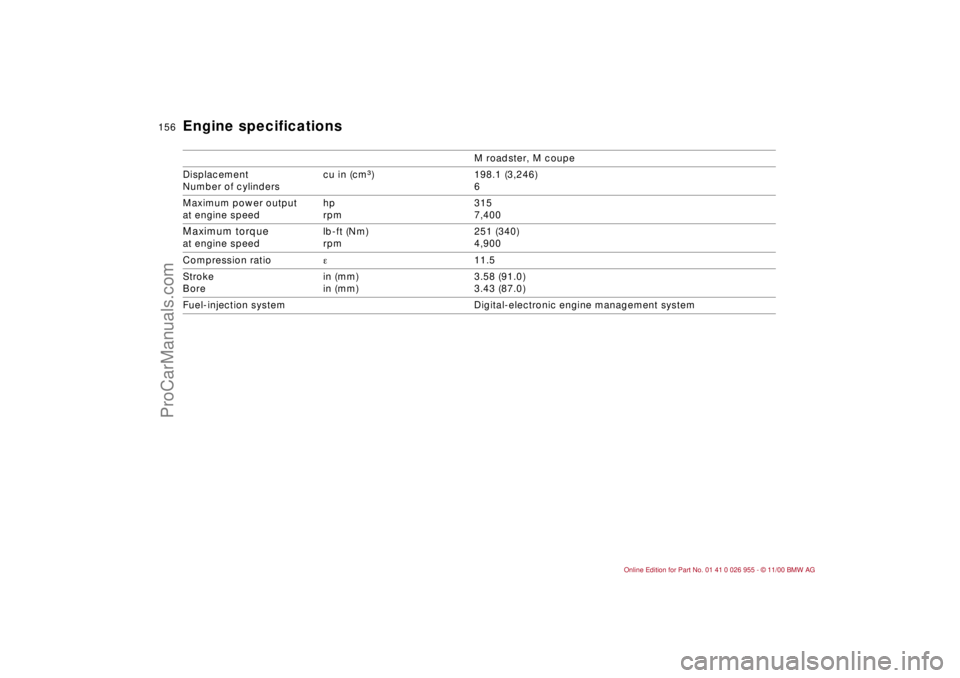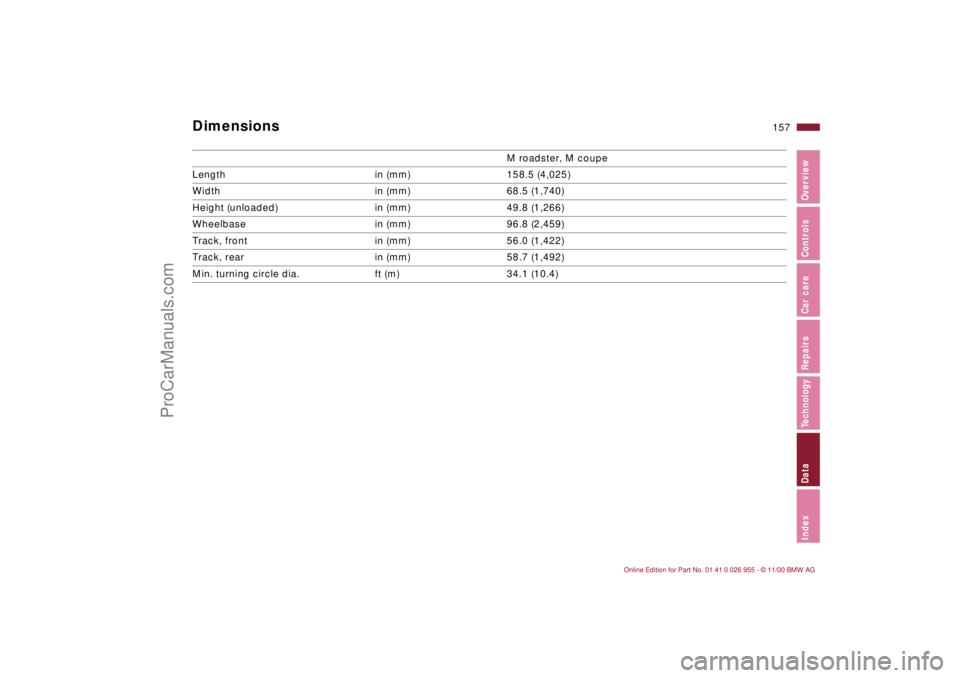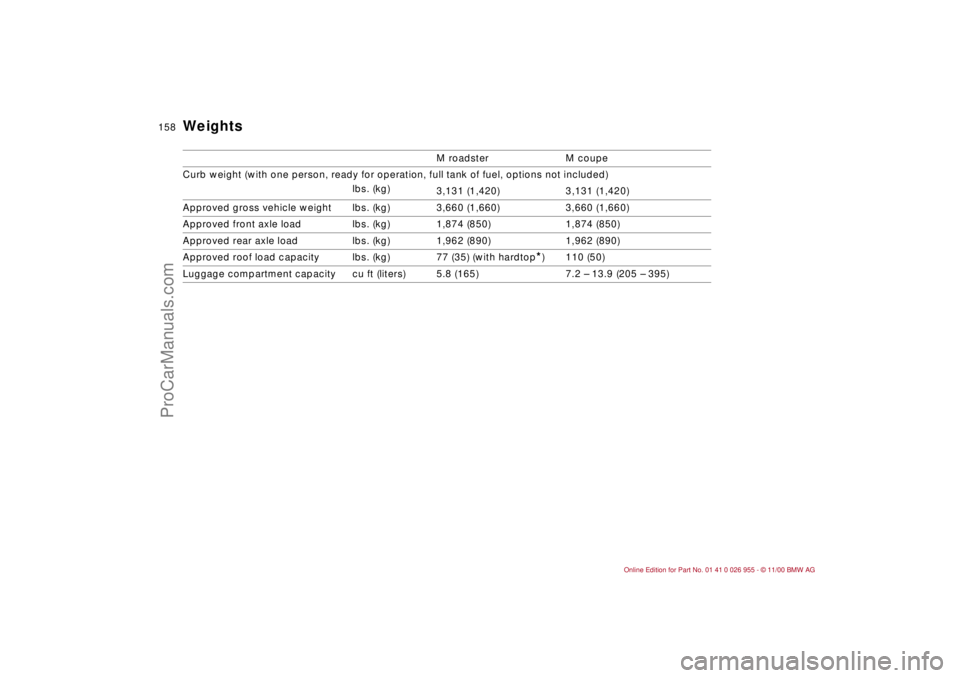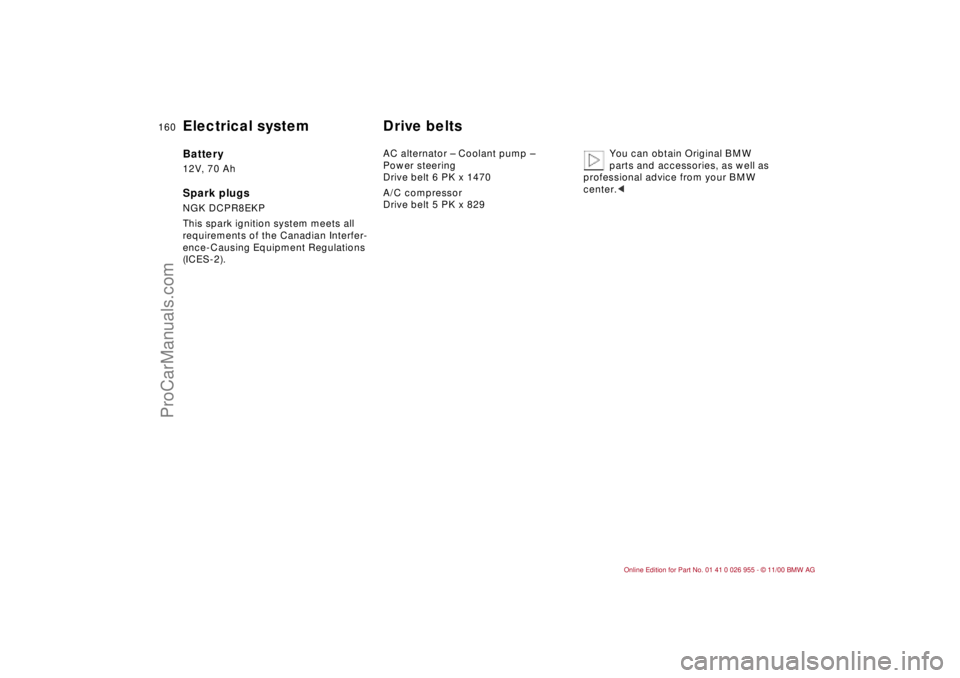BMW M ROADSTER COUPE 2001 Owners Manual
M ROADSTER COUPE 2001
BMW
BMW
https://www.carmanualsonline.info/img/1/57681/w960_57681-0.png
BMW M ROADSTER COUPE 2001 Owners Manual
Trending: oil filter, jump start terminals, deactivate airbag, ECU, set clock, fuel additives, adding oil
Page 151 of 171
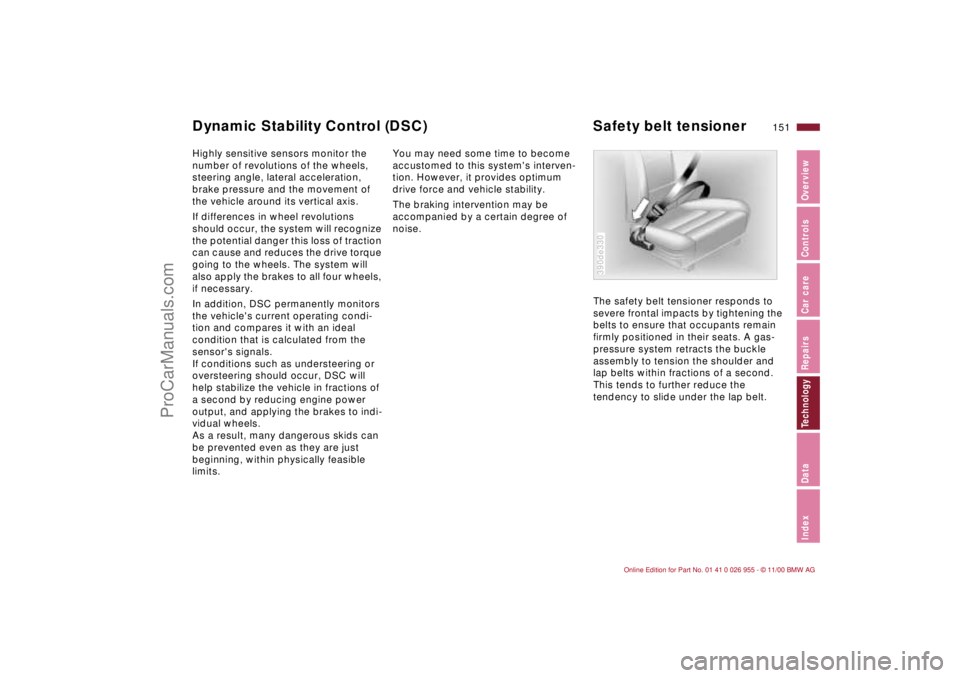
151n
IndexDataTechnologyRepairsCar careControlsOverview
Highly sensitive sensors monitor the
number of revolutions of the wheels,
steering angle, lateral acceleration,
brake pressure and the movement of
the vehicle around its vertical axis.
If differences in wheel revolutions
should occur, the system will recognize
the potential danger this loss of traction
can cause and reduces the drive torque
going to the wheels. The system will
also apply the brakes to all four wheels,
if necessary.
In addition, DSC permanently monitors
the vehicle's current operating condi-
tion and compares it with an ideal
condition that is calculated from the
sensor's signals.
If conditions such as understeering or
oversteering should occur, DSC will
help stabilize the vehicle in fractions of
a second by reducing engine power
output, and applying the brakes to indi-
vidual wheels.
As a result, many dangerous skids can
be prevented even as they are just
beginning, within physically feasible
limits.You may need some time to become
accustomed to this system's interven-
tion. However, it provides optimum
drive force and vehicle stability.
The braking intervention may be
accompanied by a certain degree of
noise.
The safety belt tensioner responds to
severe frontal impacts by tightening the
belts to ensure that occupants remain
firmly positioned in their seats. A gas-
pressure system retracts the buckle
assembly to tension the shoulder and
lap belts within fractions of a second.
This tends to further reduce the
tendency to slide under the lap belt.
390de330
Dynamic Stability Control (DSC) Safety belt tensioner
ProCarManuals.com
Page 152 of 171
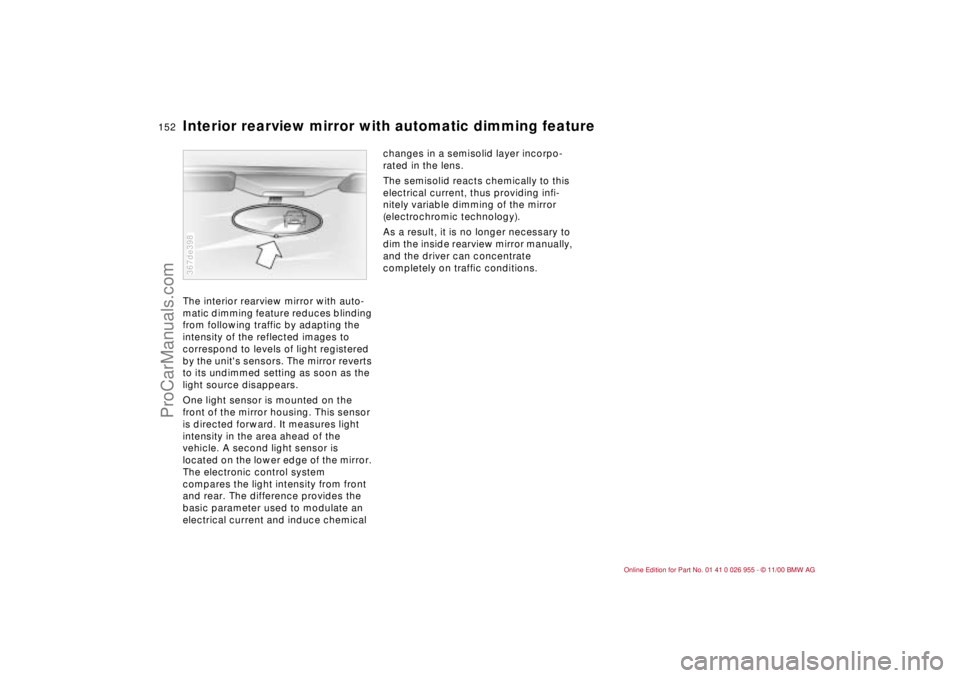
152n
Interior rearview mirror with automatic dimming featureThe interior rearview mirror with auto-
matic dimming feature reduces blinding
from following traffic by adapting the
intensity of the reflected images to
correspond to levels of light registered
by the unit's sensors. The mirror reverts
to its undimmed setting as soon as the
light source disappears.
One light sensor is mounted on the
front of the mirror housing. This sensor
is directed forward. It measures light
intensity in the area ahead of the
vehicle. A second light sensor is
located on the lower edge of the mirror.
The electronic control system
compares the light intensity from front
and rear. The difference provides the
basic parameter used to modulate an
electrical current and induce chemical 367de398
changes in a semisolid layer incorpo-
rated in the lens.
The semisolid reacts chemically to this
electrical current, thus providing infi-
nitely variable dimming of the mirror
(electrochromic technology).
As a result, it is no longer necessary to
dim the inside rearview mirror manually,
and the driver can concentrate
completely on traffic conditions.
ProCarManuals.com
Page 153 of 171
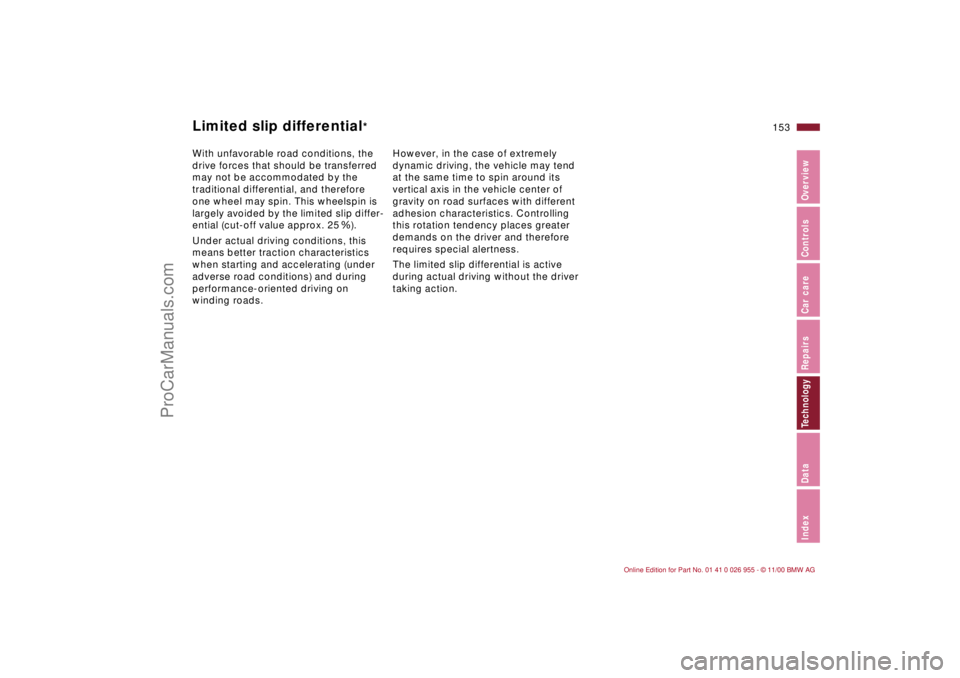
153n
IndexDataTechnologyRepairsCar careControlsOverview
Limited slip differential
*
With unfavorable road conditions, the
drive forces that should be transferred
may not be accommodated by the
traditional differential, and therefore
one wheel may spin. This wheelspin is
largely avoided by the limited slip differ-
ential (cut-off value approx. 25X).
Under actual driving conditions, this
means better traction characteristics
when starting and accelerating (under
adverse road conditions) and during
performance-oriented driving on
winding roads.However, in the case of extremely
dynamic driving, the vehicle may tend
at the same time to spin around its
vertical axis in the vehicle center of
gravity on road surfaces with different
adhesion characteristics. Controlling
this rotation tendency places greater
demands on the driver and therefore
requires special alertness.
The limited slip differential is active
during actual driving without the driver
taking action.
ProCarManuals.com
Page 154 of 171
Page 155 of 171
Overview
Controls and features
Operation, care
and maintenance
Owner service procedures
Technical data
Index Advanced technology
155n
IndexDataTechnologyRepairsCar careControlsOverview
Engine specifications156
Dimensions157
Weights158
Capacities159
Electrical system160
Drive belts160
Data
ProCarManuals.com
Page 156 of 171
156n
M roadster, M coupe
Displacement
Number of cylinderscu in (cmm) 198.1 (3,246)
6
Maximum power output
at engine speedhp
rpm315
7,400
Maximum torqueat engine speedlb-ft (Nm)
rpm251 (340)
4,900
Compression ratioe 11.5
Stroke
Borein (mm)
in (mm)3.58 (91.0)
3.43 (87.0)
Fuel-injection system Digital-electronic engine management systemEngine specifications
ProCarManuals.com
Page 157 of 171
157n
IndexDataTechnologyRepairsCar careControlsOverview
M roadster, M coupe
Length in (mm) 158.5 (4,025)
Width in (mm) 68.5 (1,740)
Height (unloaded) in (mm) 49.8 (1,266)
Wheelbase in (mm) 96.8 (2,459)
Track, front in (mm) 56.0 (1,422)
Track, rear in (mm) 58.7 (1,492)
Min. turning circle dia. ft (m) 34.1 (10.4)
Dimensions
ProCarManuals.com
Page 158 of 171
158n
Weights
M roadster M coupe
Curb weight (with one person, ready for operation, full tank of fuel, options not included)
lbs. (kg)
3,131 (1,420) 3,131 (1,420)
Approved gross vehicle weight lbs. (kg) 3,660 (1,660) 3,660 (1,660)
Approved front axle load lbs. (kg) 1,874 (850) 1,874 (850)
Approved rear axle load lbs. (kg) 1,962 (890) 1,962 (890)
Approved roof load capacity lbs. (kg) 77 (35) (with hardtop
*) 110 (50)
Luggage compartment capacity cu ft (liters) 5.8 (165) 7.2 – 13.9 (205 – 395)
ProCarManuals.com
Page 159 of 171
159n
IndexDataTechnologyRepairsCar careControlsOverview
Capacities
Notes
Fuel tank
reserve gal. (liters)
gal. (liters)approx. 13.5 (approx. 51)
approx. 2.1 (approx. 8.0)Fuel specification: page 26
Windshield washer system
including headlamp washer system quarts (liters)approx. 2.6 (approx. 2.5)
approx. 5.6 (approx. 5.3)For details: page 108
Cooling system including heater circuit quarts (liters) 11.3 (10.7) For details: page 111
Engine with oil filter renewal quarts (liters) 5.8 (5.5) "BMW High Performance
Synthetic Oil"
For details: page 110
Manual transmission – Lifetime fluid, no fluid change
required
Differential quarts (liters) 1.3 (1.2) Changing the oil during the
breaking-in inspection and
inspection II
ProCarManuals.com
Page 160 of 171
160n
Electrical system Drive belts Battery12V, 70 AhSpark plugsNGK DCPR8EKP
This spark ignition system meets all
requirements of the Canadian Interfer-
ence-Causing Equipment Regulations
(ICES-2).AC alternator – Coolant pump –
Power steering
Drive belt 6 PK x 1470
A/C compressor
Drive belt 5 PK x 829You can obtain Original BMW
parts and accessories, as well as
professional advice from your BMW
center.<
ProCarManuals.com
Trending: fuel, auxiliary battery, coolant reservoir, key battery, change wheel, fuel pressure, air suspension



